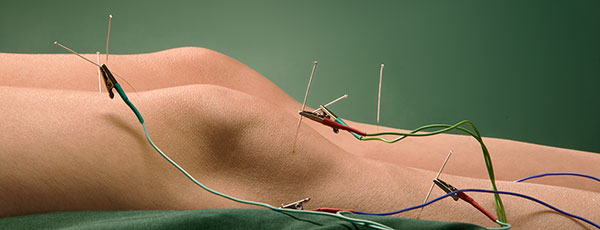As an acupuncturist specializing in musculoskeletal pain and sports injuries, I have experience, tools, and tricks up my sleeve for enabling healing and getting results. One of those tools is called Electroacupuncture. While it may sound scary or strange, electroacupuncture is painless and incredibly effective. Read on to learn what it is, how it works, and how it can help you heal faster. This is especially helpful info for those of you currently training for the NYC Marathon or the Ironman Triathlon.
To understand it better, let’s take a look at my success treating my patient David, who severely sprained his ankle four weeks ago while working out. David, one of the city’s top massage therapists and owner of Bodyworks DW (location of my office and community acupuncture clinic every Thursday), knew to come in for a session immediately after his injury—and the combination of his quick thinking, self-care and my well-placed needles helped to decrease pain and swelling, accelerate healing, and increase mobility right off the bat. I highly suggest checking out his advice on how to self-care and recover faster for a sprained ankle, without using the obsolete RICE method, here.
What is Electroacupuncture?
Think of Electroacupuncture as traditional acupuncture with a stimulating boost, or an extra “oommpf”. During a treatment, acupuncture needles first are placed in acupuncture points on the body, just like regular acupuncture. Then a micro electrical current is added to a pair of specifically selected needles by attaching small clips (imagine miniature battery jumper cables). The clips connect these needles to a small battery-operated eStim machine, and electrical pulses are generated between the two points. In David’s case, I utilized paired points to target areas of inflammation, as well as lower leg muscles that are overworking and sore.
It is an increasingly popular form of treatment for athletes and in general, and is used by practitioners of traditional Chinese medicine, including myself, for a wide array of conditions including pain and injury, neurological disorders, nausea, and even skin disorders.
How it can help treat an injury?
The added electrical current to makes the needle stimulation stronger and steadier. In cases of sports injury, I find time and time again that it helps to noticeably reduce swelling, decrease pain intensity, increase blood flow, and speed healing— as in David’s case. After our third session, we could barely see the swelling in his ankle.
Studies underscore its efficacy. A 2007 study showed that electroacupuncture had better therapeutic effects than medication, both in the short and long term, in patients with acute lumbar strain. Another compared patients with hip osteoarthritis: some had electroacupuncture, others took prescription pain reliever. There was significantly more improvement in joint pain, function and range of motion among electroacupuncture recipients than among medication recipients.
What does electroacupuncture feel like?
Most patients describe it as mild tingling or tapping. If they perceive any numbness, thumping or discomfort, I just dial the intensity back.
Are there any risks involved?
Electroacupuncture should not be used on patients who have a history of seizures, epilepsy, heart disease or strokes, or on patients with pacemakers.
How do I get it?
Contact me or book online to set up a session. I will evaluate your condition and use electroacupuncture, if appropriate. The number of sessions required depends on the condition being treated, but I generally recommend a course of four treatments to begin. Acupuncture works cumulatively, so you should experience more of an improvement with each session.
Based on years of experience treating both acute and chronic sports injuries and pain, I can say that well-performed acupuncture can make all the difference between a healthy recovery and a long, dragged out road of healing. Using electroacupuncture can be a huge addition to it's already powerful healing powers .


